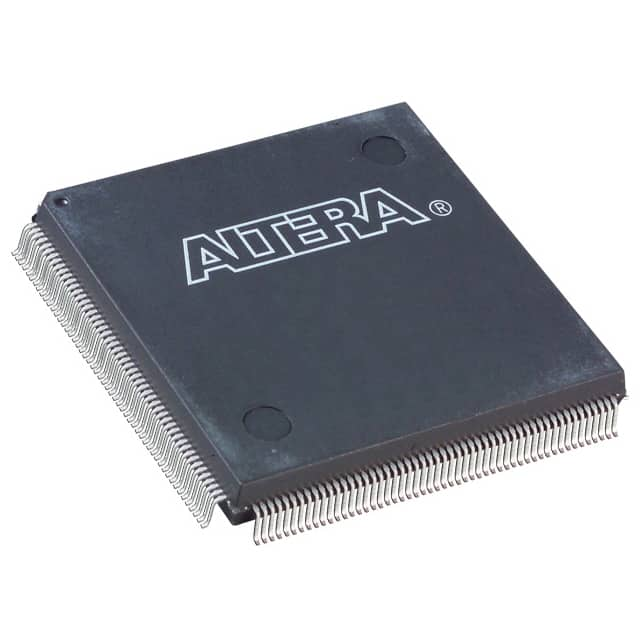Viz Specifikace pro podrobnosti o produktu.

EPF10K50EQC208-3
Product Overview
Category: Programmable Logic Device (PLD)
Use: The EPF10K50EQC208-3 is a PLD that can be programmed to perform various logic functions. It is commonly used in digital circuit design and implementation.
Characteristics: - High-density programmable logic device - 50,000 usable gates - 208-pin quad flat pack (QFP) package - Low power consumption - Fast performance
Package: The EPF10K50EQC208-3 comes in a 208-pin quad flat pack (QFP) package. This package provides a compact and convenient form factor for easy integration into circuit boards.
Essence: The essence of the EPF10K50EQC208-3 lies in its ability to be programmed to perform specific logic functions, making it highly versatile and adaptable for various applications.
Packaging/Quantity: The EPF10K50EQC208-3 is typically sold individually or in small quantities, depending on the supplier and customer requirements.
Specifications
- Number of Usable Gates: 50,000
- Package Type: 208-pin Quad Flat Pack (QFP)
- Operating Voltage: 3.3V
- Maximum Frequency: 200 MHz
- I/O Pins: 160
- Programmable Logic Blocks: 2,500
- Embedded Memory: 1,152 Kbits
- On-Chip PLLs: 4
- JTAG Boundary Scan Support: Yes
Detailed Pin Configuration
The EPF10K50EQC208-3 has a total of 208 pins. Here is a brief overview of the pin configuration:
- Pin 1: VCCIO - Power supply for I/O banks
- Pin 2: GND - Ground
- Pin 3: TDI - Test data input for JTAG boundary scan
- Pin 4: TDO - Test data output for JTAG boundary scan
- Pin 5: TMS - Test mode select for JTAG boundary scan
- Pin 6: TCK - Test clock for JTAG boundary scan
- Pins 7-10: Reserved
- Pins 11-160: I/O pins
- Pins 161-208: Dedicated configuration and control pins
For a complete pin configuration diagram, please refer to the EPF10K50EQC208-3 datasheet.
Functional Features
The EPF10K50EQC208-3 offers several functional features that make it a versatile programmable logic device:
- High-Density Logic: With 50,000 usable gates, it can accommodate complex digital circuit designs.
- Programmability: The device can be programmed to perform specific logic functions, allowing for flexibility in design.
- Low Power Consumption: It operates at low power levels, making it suitable for battery-powered applications.
- Fast Performance: The device can operate at frequencies up to 200 MHz, enabling rapid execution of logic operations.
- On-Chip PLLs: The embedded phase-locked loops (PLLs) provide clock management capabilities for precise timing control.
Advantages and Disadvantages
Advantages: - Versatile and adaptable for various applications - High-density logic capacity - Low power consumption - Fast performance - On-chip PLLs for clock management
Disadvantages: - Limited number of I/O pins compared to some other PLDs - Relatively high cost compared to simpler logic devices
Working Principles
The EPF10K50EQC208-3 is based on the concept of programmable logic. It consists of configurable logic blocks (CLBs), interconnect resources, and I/O blocks. The CLBs can be programmed to implement specific logic functions using a hardware description language (HDL) or a schematic editor.
During operation, the device reads the configuration data from an external memory source and configures its internal circuitry accordingly. This allows the EPF10K50EQC208-3 to perform the desired logic operations based on the programmed configuration.
Detailed Application Field Plans
The EPF10K50EQC208-3 is widely used in various application fields, including:
- Telecommunications: It can be used in network routers, switches, and communication equipment for signal processing and control.
- Industrial Automation: The device finds applications in programmable logic controllers (PLCs), motor control systems, and industrial monitoring systems.
- Consumer Electronics: It is utilized in digital TVs, set-top boxes, gaming consoles, and other consumer electronic devices for logic control and signal processing.
- Automotive: The EPF10K50EQC208-3 can be integrated into automotive electronics for engine control, driver assistance systems, and infotainment systems.
- Medical Devices: It
Seznam 10 běžných otázek a odpovědí souvisejících s aplikací EPF10K50EQC208-3 v technických řešeních
Sure! Here are 10 common questions and answers related to the application of EPF10K50EQC208-3 in technical solutions:
Question: What is EPF10K50EQC208-3?
Answer: EPF10K50EQC208-3 is a specific model of Field Programmable Gate Array (FPGA) manufactured by Intel.Question: What are the key features of EPF10K50EQC208-3?
Answer: Some key features of EPF10K50EQC208-3 include 50,000 logic elements, 208-pin Quad Flat Package (QFP), and support for various I/O standards.Question: What are the typical applications of EPF10K50EQC208-3?
Answer: EPF10K50EQC208-3 is commonly used in applications such as telecommunications, industrial automation, medical devices, and aerospace systems.Question: How can EPF10K50EQC208-3 be programmed?
Answer: EPF10K50EQC208-3 can be programmed using Hardware Description Languages (HDLs) like VHDL or Verilog, along with specialized software tools provided by Intel.Question: Can EPF10K50EQC208-3 be reprogrammed after initial programming?
Answer: Yes, EPF10K50EQC208-3 is a reprogrammable FPGA, allowing for multiple iterations of programming and design changes.Question: What are the power requirements for EPF10K50EQC208-3?
Answer: EPF10K50EQC208-3 typically operates at a voltage range of 3.3V, with additional power supply requirements for I/O banks and configuration pins.Question: Does EPF10K50EQC208-3 support different communication protocols?
Answer: Yes, EPF10K50EQC208-3 supports various communication protocols such as UART, SPI, I2C, and Ethernet, making it versatile for different applications.Question: Can EPF10K50EQC208-3 interface with external devices?
Answer: Yes, EPF10K50EQC208-3 has a range of I/O pins that can be used to interface with external devices like sensors, displays, and memory modules.Question: Are there any limitations or constraints when using EPF10K50EQC208-3?
Answer: EPF10K50EQC208-3 has certain limitations such as limited resources (logic elements, memory blocks), timing constraints, and power consumption considerations.Question: Where can I find more information about EPF10K50EQC208-3?
Answer: You can refer to the official documentation provided by Intel, including datasheets, application notes, and user guides for detailed information on EPF10K50EQC208-3.

